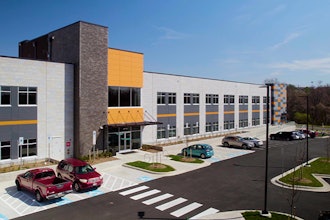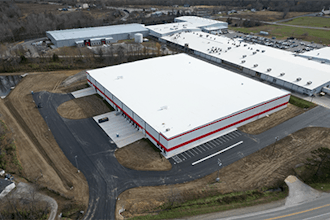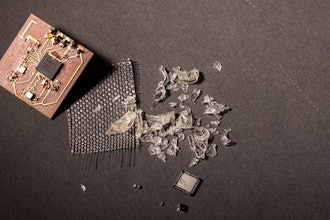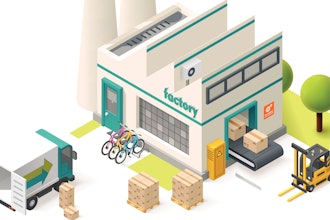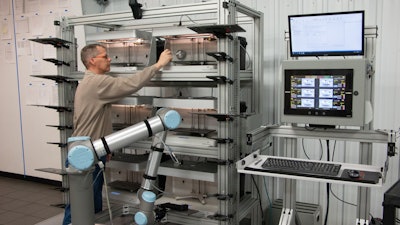
EVCO Plastics in DeForest, Wisconsin is a custom injection molder facing the challenge of having to staff round-the-clock production with fast-changing processes. A mobile fleet of Universal Robots now handles a wide range of tasks such as dispensing, assembly, quality inspection, harvesting of 3D printers and packaging.
“Three years ago, people didn’t know what a collaborative robot was. Now everybody wants one.” Bernie Degenhardt, automation manager at EVCO Plastics, recalls his journey watching cobots emerge before deploying four cobots from Universal Robots (UR) that now alleviate workers’ repetitive tasks throughout EVCO’s Wisconsin plant. “I was looking at other brands, and what I liked about UR is just being able to do fairly complicated tasks with limited training,” he said.
Jason Glanzer, automation engineer at EVCO plastics, is not new to robotics—EVCO has numerous traditional, Cartesian robot cells—but what surprised him about the cobots was “how nicely they play with others” as he puts it.
“The biggest difference between hard automation and collaborative robots is the set-up time. These cobots interface well with many products--UR has really been on top of continuously improving compatibility, which was really important for us,” he said, highlighting the UR+ platform that certifies grippers, vision cameras, software and other peripherals to work with UR cobots.
 Universal Robots
Universal Robots
Intricate assembly cell simplified
EVCO Plastics has now deployed two UR5s and two UR10s at the DeForest plant. Named after their payload in kilos, the cobots are placed on wheels and can be moved around the factory floors. One UR5 is currently deployed in an intricate assembly task. In the cell, the UR5 picks up a gearbox used in lawn mowers, places it into a grease dispenser and then inserts a cap to seal the grease port.
Placing the cap correctly is a tricky task made simpler by the UR+ certified FT300 force/torque sensor from Robotiq.
“Adding the sensor to the end of the UR5 arm allows the cobot to “feel” when the cap is inserted correctly, using a spiral motion,” explained Glanzer.
The UR+ software handshake means that all programming of the sensor happens directly through the cobot’s teach pendant, with the same intuitive interface used to program the cobot itself.
“Without the UR+ integration we would have had to create a considerable amount of script code to accomplish a task like this,” explained Glanzer.
The UR5’s teach pendant has two other UR+ interfaces: a Cognex vision camera and an Asycube Flexible Part Feeder from Asyril. The feeder spits out the caps on a surface that vibrates until the caps are spread out facing the right side up, then the vision camera mounted above the surface snaps an image of the caps’ positions, instructing the UR5 on where to pick them up.
“Being able to control every part of the cell through the cobot means that it essentially becomes the PLC,” said Glanzer. “It reduces a lot of system costs and programming time up front. Traditionally it would take up to several weeks or more to automate a new project; whereas now, you roll the cobot out to the floor, you do some programming and it can be up and running in two days.”
After the cap is successfully inserted, the UR5 places the gearbox on a scale to make sure the grease has been added. If the gearbox does not weigh the correct amount, the UR5 places it in a reject box.
“Once the UR5 takes control of the part, we know we were going to get a good part,” said Glanzer.
This is in contrast to human operators, who were prone to forget steps in the assembly process.
The simple set-up and operation of the cobots also means that EVCO can run them on the third shift without having to rely on having automation engineers on hand.
“If something goes wrong in the middle of the night, one of our set-up guys can go over there and get the cell up and running without having to call an automation technician or engineer onto the plant floor,” he explained.
Packaging in tandem with Cartesian robot
Next door, in EVCO’s vast injection molding hall, Cartesian robots de-mold parts and place them on a guarded conveyor. A UR10 picks up the parts from the conveyor and places them in a box using the cobot’s built-in palletizing wizard.
“This is another process that is really simplified now,” said Glanzer. “Using the palletizing routine means there’s a lot fewer positions that need to be taught, you’ll have a lot more consistency, and you don’t need to run external counters to keep track of where you’re at in your program and where you’re stacking the parts.”
Like the UR5 in the assembly cell, the UR10 on the packaging line also uses force/torque sensing: first to check that all four corners of the box are where they’re supposed to be, and second to place cardboard sheets between each layer of parts in the box.
 “I was looking at other brands, and what I liked about UR is just being able to do fairly complicated tasks with limited training,” said Bernie Degenhardt (left), automation manager at EVCO Plastics.Universal Robots
“I was looking at other brands, and what I liked about UR is just being able to do fairly complicated tasks with limited training,” said Bernie Degenhardt (left), automation manager at EVCO Plastics.Universal Robots
3D printer harvesting
Another tedious task now automated with a UR10 is the harvesting of plates in EVCO’s 3D printer farm, which consists of six polymer printers that run 24/7 to serve EVCO’s own internal tooling needs as well as to produce parts for outside customers.
“We were looking for a way to switch out used build plates so that production could continue without employee intervention,” explained Glanzer.
The printer cell can now work continuously without human oversight for as long as build plates are available. The printers communicate with the cobot via Wi-Fi. If designers want to change the quantity—amounts of prints or models that need to be built—they can send out an email from their desk to change the value of how many times the robot needs to restart the printer or clear it for the next build.
“We can run the printers 24 hours a day now, which we couldn’t do before,” said Glanzer, adding that EVCO can now do even very small runs cost-efficiently.
A recent example is a tripod mount for a spotting scope used by hunters and bird watchers. The customer is an online retailer that needed just 50 of these parts. It’s a job that EVCO normally wouldn’t be able to do cost-effectively, given the small batch size.
“We plan to take on more jobs like this. By mirroring the existing array, adding an additional six printers, with the UR10 on a track to travel between them, it’s infinitely flexible. The possibilities are part of the beauty of the solution,” Glanzer added.
Labor savings and flexibility
Being located in a region with low unemployment resulted in EVCO having trouble staffing the third shift, and manning cells with repetitive and tedious tasks was especially hard.
“Getting people to stick around long-term is difficult, leading to a lot of turnover,” said Andy Prell, EVCO’s production manager. “Universal Robots allows us to do the same amount of work with fewer people, so it helps mitigate that challenge.”
He explained how operators have traditionally handled one or maybe two machines at a time.
“That really limits what we can produce on any given shift. Now we can use one operator to run several machines concurrently, which allows us a lot of flexibility in our operation.”
 The molded parts arrive from the Cartesian robot via conveyor to the UR10 that picks them up and places them in boxes.Universal Robots
The molded parts arrive from the Cartesian robot via conveyor to the UR10 that picks them up and places them in boxes.Universal Robots
Spreading cost between jobs delivers quick ROI
Automation manager Degenhardt is quick to summarize what that means to the bottom line.
“Eliminating the labor cost allows us to run basically two jobs for the cost of one UR robot, so the payback comes quite quickly that way,” he said, estimating current ROI on EVCO’s UR cobots is between six and nine months. Adding to the quick payback are also savings on workers’ compensation.
“This is a big deal,” he said. “The cobots help reduce any kind of repetitive strain injuries so we actually get a lower rate, which is a huge cost savings to us.”
No waste of intelligent labor
Degenhardt emphasizes that the cobots are not replacing his existing workforce.
“Having a human do monotonous, repeatable tasks is kind of a waste of intelligent labor,” he stated. “The operator will go to a higher level, something that requires more dynamic thinking such as quality checks, other things like that. I think they see the UR as a tool; you put it on the floor, and it’s not caged off or isolated. The operator feels they’re working with the robot, not against it.”
Built-in safety saves both cost and space
The built-in safety system in the UR cobots make them automatically stop when they encounter obstacles in their route. Based on a risk assessment of the application, a vast majority of UR cobots operate right alongside workers with no safety guarding, as is the case at EVCO.
“Real estate is important: our production floor gets really tight, we’re constantly changing out molds, we have a lot of forklift and crane traffic,” said Glanzer. “Not having to put up guarding really opens up a lot of space for us, enabling us to keep production running on one cell while we’re doing a mold change on the other.”
Direct human-cobot collaboration is seen on the packaging line, where an operator takes the packaged box directly from the UR10 and tapes it shut. The benefit is not only space savings; it’s also a significant cost saver.
“With standard robots, all the guarding, safety relays and light curtains can add thousands of dollars to the cost. With cobots none of this is necessary,” said Glanzer.
UR changes the formula
Due to the mobile nature of the UR cobots, these cost savings can now be spread out between many different jobs.
“We don’t come to the customer with this large cost, saying; ‘Hey, you need to buy this robot that’s going to run this one job.’ We take the cost and we allocate it out over several customers, so that makes us really cost-competitive,” explained Degenhardt, adding how in the past his team was always stuck in the quandary between adding more labor vs. deploying automation. “We would start adding up the price of automation and it just didn’t make sense. UR changes that formula quite a bit."













